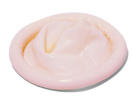One of the most common methods of protection used to prevent the transmission of STDs is the latex condom. Condoms are sheaths of thin latex or plastic worn on the penis during intercourse. And they are available dry or lubricated. Sometimes they are called rubbers, safes, or jimmies. They reduce the risk of sexually transmitted infection. They are also an effective over-the-counter, method of birth control.
According to the Planned Parenthood Federation of America, "Of 100 women whose partners use condoms, about 15 will become pregnant during the first year of typical use.* Only two women will become pregnant with perfect use.** More protection against pregnancy is possible if condoms are used with a spermicide foam, cream, jelly, suppository, or film. *Typical use refers to failure rates when use is not consistent or always correct. **Perfect use refers to failure rates for those whose use is consistent and always correct."
In addition to their ability to protect the users from unwanted pregnacies, condoms are unique in the methods of birth control in that they also protect the users from sexually transmitted diseases. For this reason, condom use is often suggested even in the presence of other protection methods such as pills or spermacides.

a condom
